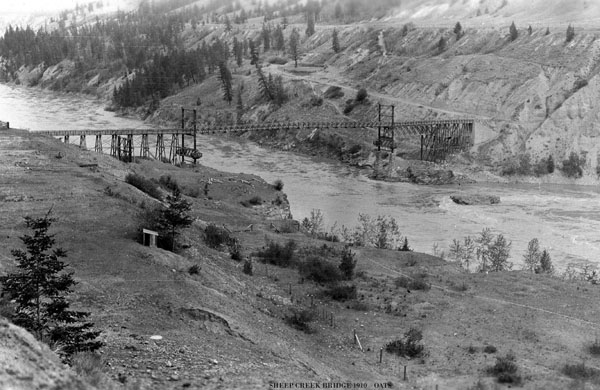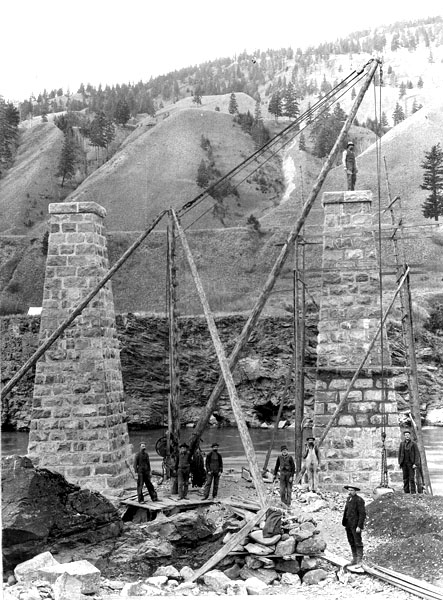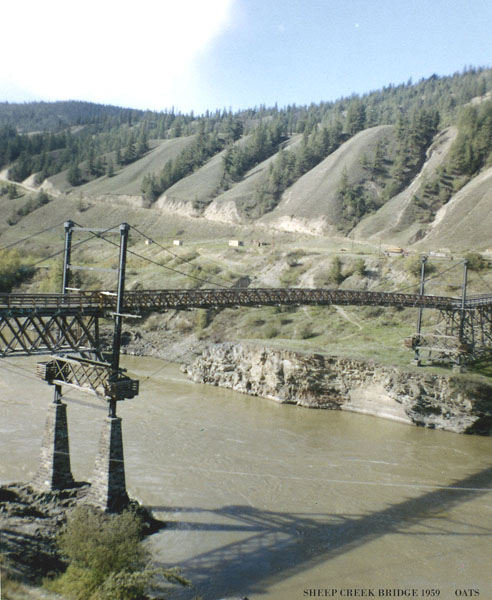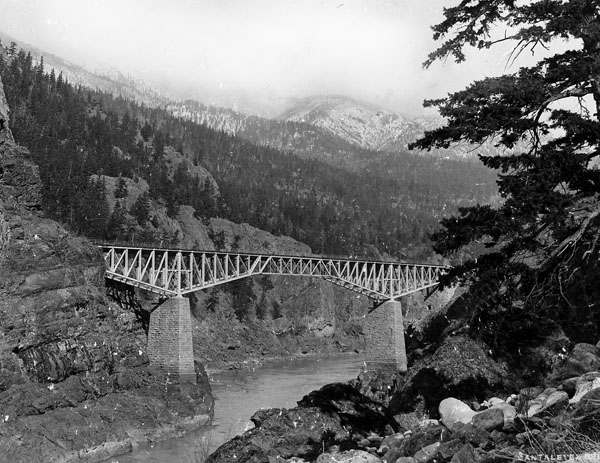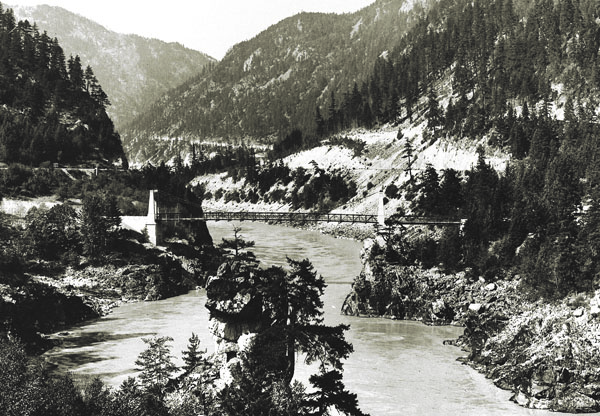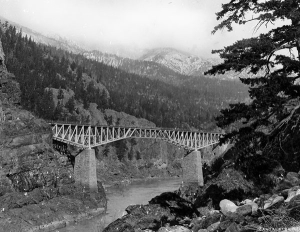WALKING THE WIRE
Suspension Bridges over the Fraser River
An Essay by Brian Wilson
I have always been fascinated by the methods gold-seekers to the Cariboo crossed the mighty Fraser River. This river is not a creek to ford; it’s a killer of a river that only the most foolish of men would try to cross without caution. The Royal Engineers under Governor Douglas were the enablers of crossings of the river to the goldfields. There were no fewer than three bridges built over the torrent between 1863 an 1868. Two still exist today.
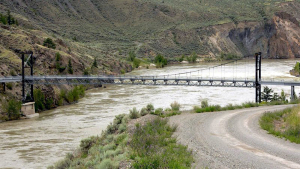
Part of the Port Douglas road to Lilloett became the Gang Ranch. The suspension bridge at Churn Creek (Dog Creek), built in 1863, is still used by the ranch today. The Alexandra bridge near Spuzzum is a heritage site next to the new Highway 1 bridge.
With the discovery of the Murchie collection of glass negatives came a chronicle of the building of another suspension bridge over the Fraser that few remember. It is the Chimney Creek Bridge near William’s Lake that became Highway 20 to Bella Coola. It was built by a pioneer of modern bridge building, Sam Smith. Not a lot is known of Sam Smith’s background. As he was a BC native and had a home in New Westminster at the turn of 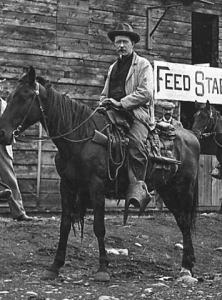
Archibald Murchie at Princeton 1905
the century, it is assumed that he had worked on several other bridges, including the unusual cantilever bridge in the Fraser Canyon, the Cisco CPR railway bridge at Keefers.
This assumption is because Mr. Smith worked for Waddell and Hendrick, famed North American bridge builders and structural Engineers. As a matter of fact, Sam worked for the most famous of all suspension bridge designers, James A. L. Waddell of Kansas City (even in modern times Mr. Waddell is thought of as the Father of the Wonders of Engineering) and Waddell designed the Cisco bridge.
By 1901 the contract was set for Chimney Creek and the call for workers to build the 325 foot suspension bridge went out. It was to be a unique span with a lower counterweight to provide rigidity and overcome movement and ‘windlift’ common to suspension bridges. It was indeed, a handsome structure between graceful towers, an 80 foot Howe Truss on the east side and a 225 foot trestle approach to the west. Smith brought over 60 skilled workers in from across the country, including those who could feed and house them in the little village set up at the site.
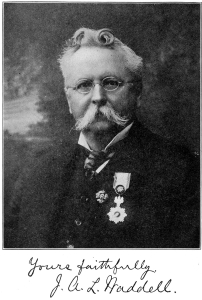 Now let’s put this project into perspective. The Provincial Government of the day led by Premier Edward Prior; was petitioned to build this bridge by a voting population of 40 white males, the total eligible voters of the Chilcotin. They insisted the bridge would bring prosperity to the entire heartland of the Province, and enable the production of cattle and sheep to feed the world.
Now let’s put this project into perspective. The Provincial Government of the day led by Premier Edward Prior; was petitioned to build this bridge by a voting population of 40 white males, the total eligible voters of the Chilcotin. They insisted the bridge would bring prosperity to the entire heartland of the Province, and enable the production of cattle and sheep to feed the world.
The Premier was in fact, in the business of engineering and had a successful mining supply firm. With this background, how could he refuse them their bridge?
The site chosen was tenmiles down river from Chimney Creek, called “Sheep Creek” by the local ranchers. This was a good location for the bridge but extremely remote for the shipment of materials. Most of the supplies had to be unloaded at the Ashcroft railhead and hauled by wagon or sleigh many miles up the Cariboo Trail, then on through uncharted cattle tracts to the Fraser River. A young ranch hand named Henry Durrell, with more education than usual, took on the task of keeping the workers on
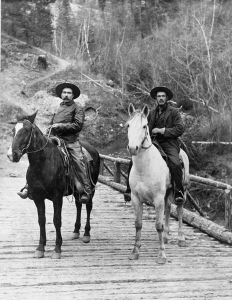
the site. Some who made the trek in, turned tail and left after seeing the difficult terrain at the crossing. Durrell made sure there was ample liquor and good food to reward the hard labour of those who remained.
Durrell acted as foreman to make continuous flow. He arranged drovers from as far away as Kamloops to join what looked like a convoy of 20 mule-team pack trains to haul the granite pier stones, weighing up to 450 pounds each, and the numbered prefabricated timbers to the site. It sometimes took two weeks to get to the bridge site and it was Henry that made sure they were placed without delay. But the story gets more interesting when the call goes out to supply the 700 foot, 2 ¾ inch suspension cables.
The good Premier Prior was also acting as the Minister of Lands and Works when the call to supply these cables went out to tender. When the bids came in, the Premier noticed that his Manager, of Prior & Co., had not bid. Perceiving a conflict-of-interest the Manager, in all honesty, could not bid; but the Premier did. As he had viewed the other bids, his bid was the lowest and his Company got the contract.
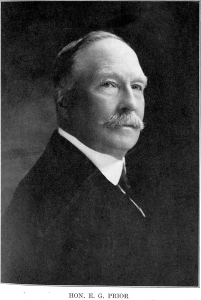 The Legislature was livid and called for his head, but Premier Prior wouldn’t resign. Prior’s gentry was his downfall as he stated he was privileged as a Militia Colonel
The Legislature was livid and called for his head, but Premier Prior wouldn’t resign. Prior’s gentry was his downfall as he stated he was privileged as a Militia Colonel
and previous Lieutenant Governor of the Province. He could do no wrong. Out of the turmoil stepped Lieutenant Governor, Sir Henry Joly de Lotbiniere and fired Premier Prior. The Government of the Province fell.
The bridge opened in 1904, but as time went on, the Bridge became a pariah for the locals. It squeaked and squawked and swayed; it spooked man and beast that used it. As automobiles became popular, no one was fool enough to drive onto it when anything else was on it. But it remained a valued part of the route to Bella Coola until it was replaced by a new bridge and blown to bits in 1962.
Sources:
The Road Runs West, Diana French 1994 – Harbour
BC Biographical 1914
Bridge Engineering, Waddell 1923
Murchie Collection of Photographs

